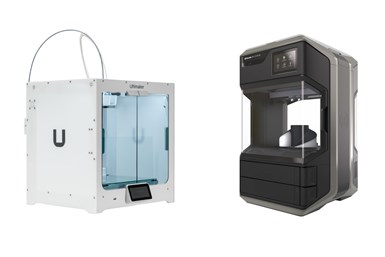MakerBot, Ultimaker Announce Merger
By combining teams and leveraging additional funding, the merged company aims to accelerate the development of advanced solutions to provide customers with a broad portfolio of hardware and software solutions to serve a wide spectrum of customers and applications.

Ultimaker - UM S5 + MB Method X. Photo Credit: Ultimaker and MakerBot
MakerBot and Ultimaker have agreed to combine their businesses in an effort to accelerate the adoption of additive manufacturing (AM) by providing a comprehensive desktop 3D printing ecosystem of hardware, software and materials.
The new entity will be backed by existing investors, NPM Capital and Stratasys, and will benefit from a planned further cash investment to fuel innovation and expansion into new markets. The new company will be led by Nadav Goshen, current MakerBot CEO, and Jürgen von Hollen, current Ultimaker CEO, who will act as co-CEOs, with Nadav managing operations and R&D, while Jürgen manages the commercial functions.
“This merger marks an important milestone for Ultimaker and MakerBot,” von Hollen says. “Innovation and growth are both critical to bringing desktop 3D printing from a specialty technology into mainstream business adoption. The new company will leverage and expand its combined global footprint with sales and operations in the Americas, EMEA and APAC.”
The new entity aims to offer easy-to-use and accessible desktop 3D printing solutions for any application while inspiring the industry to a future state of responsible and sustainable manufacturing, the company says.
“Technological innovation is paramount in growing the availability of easy-to-use professional 3D printing solutions,” Goshen says. “By combining our teams and leveraging the additional funding, we can accelerate the development of advanced solutions to provide our customers with a broad portfolio of hardware and software solutions to serve a wide spectrum of customers and applications."
The new company will maintain headquarters in both The Netherlands and the U.S. The transaction is subject to consultation of appropriate employee representative bodies and regulatory approvals, with closing expected over the course of the second or third quarters of 2022.
Related Content
-
FDA-Approved Spine Implant Made with PEEK: The Cool Parts Show #63
Curiteva now manufactures these cervical spine implants using an unusual 3D printing method: fused strand deposition. Learn how the process works and why it’s a good pairing with PEEK in this episode of The Cool Parts Show.
-
3D Printed Lattices Replace Foam for Customized Helmet Padding: The Cool Parts Show #62
“Digital materials” resulting from engineered flexible polymer structures made through additive manufacturing are tunable to the application and can be tailored to the head of the wearer.
-
3D Printing with Plastic Pellets – What You Need to Know
A few 3D printers today are capable of working directly with resin pellets for feedstock. That brings extreme flexibility in material options, but also requires greater knowledge of how to best process any given resin. Here’s how FGF machine maker JuggerBot 3D addresses both the printing technology and the process know-how.










